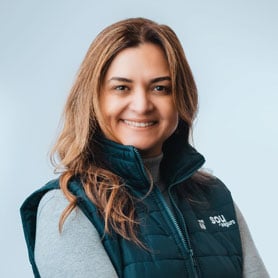Luciana Côrtes Carvas: Transforming security into a strong and non-negotiable value
With an extensive background in human resources, Luciana Côrtes Carvas drives workplace safety at São Martinho with great authenticity, ensuring her career journey is an opportunity to influence, care for and lead people in a respectful and enjoyable way. With 12,500 people working for this organisation, amongst the largest sugar-energy groups in Brazil, the responsibility is large.


Luciana Côrtes Carvas
Human Resources, Occupational Health & Safety and Social Responsibility Director, São Martinho
Q.
What connected you to Occupational Safety throughout your career?
My career has been built over time within the vast array of Human Resources disciplines. It is undeniable my choice to work in this area originates in my passion for collaborating, leading, and influencing people.
My connection with the topic of safety is no different. It is a key discipline with multiple complex technical features, but I firmly believe human behavior also plays a critical part when striving for a safe environment.
Therefore, I have really welcomed the opportunity to lead both topics - Safety and HR - in my current role. Ultimately, I seek to integrate them into a common objective, which is the care of our most important asset: our people. This perspective has always inspired me, and has made my career journey a really enjoyable opportunity to influence, care for, and lead people.
“Safety culture fosters open and transparent communication.”
–Luciana Côrtes Carvas, Human Resources, Occupational Health & Safety and Social Responsibility Director, São Martinho
Q.
Talking about human behaviour, how can leadership make a difference in making operations safer?
Organisational culture, combined with the effective role of leadership, plays a key part in building safer operations.
At São Martinho, we have evolved the way we position safety procedures and practices: increasingly, safety is not a process but a value for our company and our people.
Counting on our entire leadership, we are committed to ensuring an appreciation of risk permeates all operations. It is worth highlighting that "Our Way of Being" , belief that guide us and which reflects the care for our people, attitudes and business, reinforces the importance of this topic on a daily basis and at all hierarchical levels.
It is important to highlight that an effective safety culture fosters open and transparent communication, for example encouraging our employees to report concerns, incidents, or ideas for continuous improvement. This is promoted through inspiring leadership who act as role models by strictly following procedures, systematic using Personal Protective Equipment (PPE) and demonstrating a visible commitment to safety in all their actions.
Q.
What are the key considerations for safety culture improvement and what happens when initiatives don't work?
To improve your organisational safety culture, it is important to consider various practices and approaches. This starts with leadership, which has to demonstrate a clear and visible commitment to the topic, incorporating it into their daily activities and consistently communicating its importance to the whole company. Furthermore, when it comes to safety, the promotion of clear and open communication at all levels is essential. Employees must have adequate training and qualifications to perform their tasks safely.
Safety culture must be evaluated regularly, allowing the organisation to identify opportunities for improvement. This prevents initiatives from proving inefficient and ensures an environment where everyone can return home safely.
“Safety must transcend the technical sphere and assume a determining role as a value for the organization.”
–Luciana Côrtes Carvas, Human Resources, Occupational Health & Safety and Social Responsibility Director, São Martinho
Q.
What is your opinion on addressing psychosocial issues in safety programs?
Addressing psychosocial issues in safety programs is essential to promote a healthy and safe work environment. Psychosocial issues cover elements in the work environ-ment that impact the psychological and social well-being of employees, such as stress, work overload, harassment, and interpersonal conflicts, among others.
In my opinion, incorporating these aspects into our safety programmes demonstrates our commitment to care, as reflected in “Our Way of Being” which I have mentioned before. This is essential to our company's success.
Safety overall must transcend the technical sphere and take on a critical as a value for the organisation.
Q.
Based on your experience, what impacts do other areas, such as sustainability, operational risk management, and operational excellence, have in helping to create a secure business that is better positioned to withstand industry volatility and succeed over the long term?
Areas such as sustainability, risk management, and operational excellence play crucial roles in creating a secure and successful business, especially in an industry prone to volatility.
Integrating sustainable practices into the company's operations can result in significant benefits for safety. For example, the adoption of cleaner and more efficient technologies can reduce exposure to dangerous substances and minimise the risk of environmental pollution.
Effective risk management is essential to identify, assess, and mitigate potential threats to the company's operations. This includes not only physical safety risks such as accidents and injuries but also financial, regulatory, and reputational risks that can affect long-term security.
Operational excellence, on the other hand, drives the company to create a safer and more resilient work environment, where employees are well-trained, equipment is properly maintained and used, and risks are proactively identified and mitigated.
Safety can and should go hand in hand with productivity. We don't believe that one thing is separate from the other.
Q.
We know that innovation and technology can be leveraged to improve safety programs. What is your experience with this topic and what are the main challenges in implementation?
São Martinho has led the adoption of new technologies and continuous innovation, both in the industry in which we operate and in new businesses. It's no different when we talk about safety. We believe in continuous improvement of processes, creating conditions for the implementation of new solutions and tools that help us on this journey, aiming to provide a safer environment for everyone.
“Effective operational risk management is essential to identify, assess and mitigate potential threats to the company's operations.”
–Luciana Côrtes Carvas, Human Resources, Occupational Health & Safety and Social Responsibility Director, São Martinho
Q.
What do you consider to be essential elements to building a sustainable safety program?
At São Martinho, we built the SOU Program (safety program that means I’m) which, in a disciplinary and essential way, reflects the importance and company's care for this topic. Our main objective is to be a leader in operational risk management, focusing on the goal of five years without fatal, serious or lost-time accidents, based on initiatives and projects aimed at transforming the behaviour of our people and processes.
I can say the engagement of all hierarchical levels, the in-depth diagnosis with intense field research and everyone's willingness were essential for our journey to begin in a very responsible and solid way. We do not doubt that we will increasingly transform safety into a very strong and non-negotiable value for our company.
“Leadership needs to set an example, and act correctly in a very simple way.”
–Luciana Côrtes Carvas, Human Resources, Occupational Health & Safety and Social Responsibility Director, São Martinho
Q.
What initiative or action have you taken in your career that made a difference and that you are most proud of?
Safety needs to be addressed by each leader with two essential points in mind. The first one is to consider safety as a value. When we treat it as value, we don’t bargain or compromise. The second point is to lead by example. Leadership needs to set an example and act correctly in a very simple way, but undoubtedly in a very strong and effective manner, always reinforcing that “actions speak louder than words”.
These two principles have guided me. I am very proud to be a leader who treats safety as a value and leads by example.